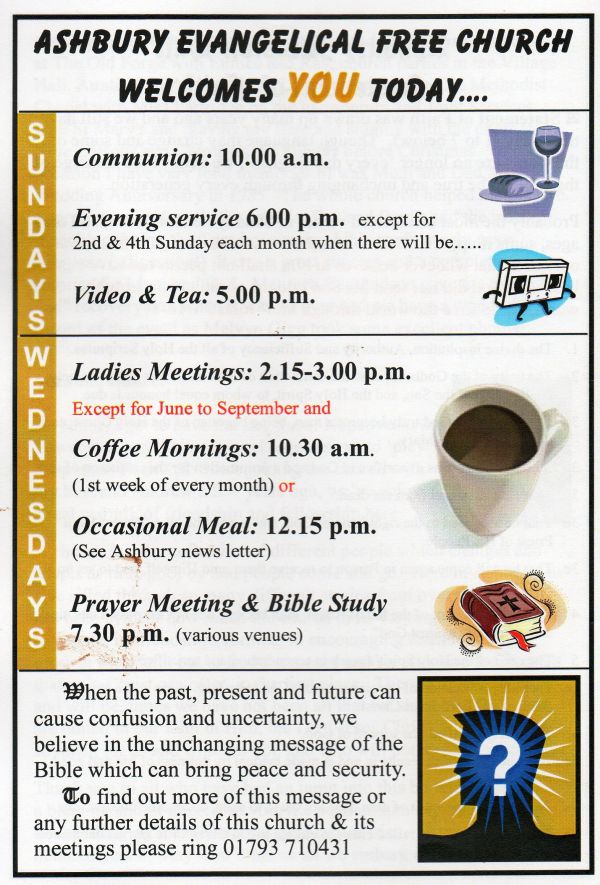(Reproduced with kind permission of Suzanne Bunce who collated and edited the booklet)
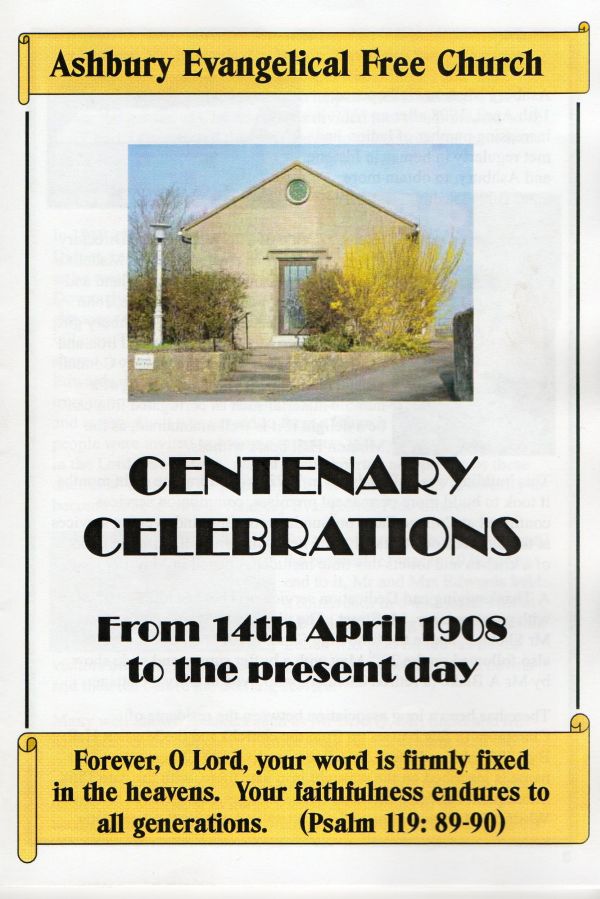
The Building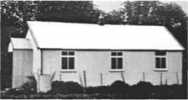
Ashbury Mission Hall opened 14th April, 1908 after an increasing number of ladies had met regularly in homes in Idstone and Ashbury, to obtain more good Bible teaching.
 The 1912 Vale of The White Horse Directory shows the Hall was erected by Miss Madeline Hedges (she personally paid for the land and the building) in memory of her uncle, John Spindloe. a miller, married to an Ashbury girl, Mary. Constructed from corrugated iron and painted sky blue, a Berkshire County Council village plan stated, “even a building of a humble material such as corrugated iron can be a delight if it is well maintained, as the Mission Hall bears witness.”
The 1912 Vale of The White Horse Directory shows the Hall was erected by Miss Madeline Hedges (she personally paid for the land and the building) in memory of her uncle, John Spindloe. a miller, married to an Ashbury girl, Mary. Constructed from corrugated iron and painted sky blue, a Berkshire County Council village plan stated, “even a building of a humble material such as corrugated iron can be a delight if it is well maintained, as the Mission Hall bears witness.”Leadership
 Downs distributing Christian almanacs to lonely cottages and villages. Two years later he married Miss. Hedges and together they shared the responsibility for the Mission Hall and its work until Mrs. Edwards died in 1954. In November 1958 Mr. Edwards formed a trust to protect the material and spiritual interest of the Mission Hall and eventually it was agreed to form a ‘church fellowship’ where people were invited to become members if they had a ‘saving belief in the Lord Jesus Christ’ and ‘a whole hearted acceptance of these doctrines’ (outlined on page 23). The mission hall was eventually to become to be known as Ashbury Evangelical Free Church.
Downs distributing Christian almanacs to lonely cottages and villages. Two years later he married Miss. Hedges and together they shared the responsibility for the Mission Hall and its work until Mrs. Edwards died in 1954. In November 1958 Mr. Edwards formed a trust to protect the material and spiritual interest of the Mission Hall and eventually it was agreed to form a ‘church fellowship’ where people were invited to become members if they had a ‘saving belief in the Lord Jesus Christ’ and ‘a whole hearted acceptance of these doctrines’ (outlined on page 23). The mission hall was eventually to become to be known as Ashbury Evangelical Free Church. conference in a 400 seater tent in the field adjoining the Mission Hall. Lunch was held on the lawns for visitors after the morning service, followed by walks on the downs and then tea before the evening service. Many well known speakers such as Mr Brierly, Mr. Short and Mr. Montague Goodman came. Eunice Gigg recalls dealing with the practicalities such as smearing whitewash on the scullery windows so visitors weren’t overlooked going to the outside toilet and being on her best behaviour at home when a speaker had to be accommodated! The annual Swindon convention, celebrating its 75th year this year, grew out of the Ashbury conventions with many people travelling from Swindon to
conference in a 400 seater tent in the field adjoining the Mission Hall. Lunch was held on the lawns for visitors after the morning service, followed by walks on the downs and then tea before the evening service. Many well known speakers such as Mr Brierly, Mr. Short and Mr. Montague Goodman came. Eunice Gigg recalls dealing with the practicalities such as smearing whitewash on the scullery windows so visitors weren’t overlooked going to the outside toilet and being on her best behaviour at home when a speaker had to be accommodated! The annual Swindon convention, celebrating its 75th year this year, grew out of the Ashbury conventions with many people travelling from Swindon to  attend. Other events, like the speaking rally by Gipsy Smith pictured, were arranged.
attend. Other events, like the speaking rally by Gipsy Smith pictured, were arranged.
God uses the Mission Hall
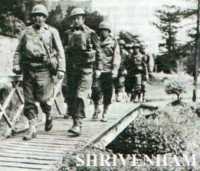 afterwards to supper by church members. The church was opened week days to give soldiers peace and quiet to relax and write letters home. Mr Edwards had a pass to go into all the military camps in the country, of which he made full use. Every Christmas Mrs Edwards sent parcels to the soldier boys of the village for which the ladies knitted balaclavas, scarves, socks and gloves. Eunice Gigg went round the village collecting the boy’s addresses and recalls, after the war, hearing one say how much these parcels meant.
afterwards to supper by church members. The church was opened week days to give soldiers peace and quiet to relax and write letters home. Mr Edwards had a pass to go into all the military camps in the country, of which he made full use. Every Christmas Mrs Edwards sent parcels to the soldier boys of the village for which the ladies knitted balaclavas, scarves, socks and gloves. Eunice Gigg went round the village collecting the boy’s addresses and recalls, after the war, hearing one say how much these parcels meant.Ministry to women
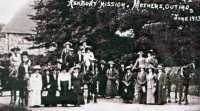 with various female speakers. 40 to 45 women attended! They brought knitting and sewing to do while listening to the talks & brought their children, and sweets to keep them quiet! Until we had a kitchen, two well wrapped pots of tea and a kettle of boiling water were brought in each week. Dr Bergin’s wife Pam used to cause a ‘minor stir’, standing up during the meeting to try to see where the local hunt was!
with various female speakers. 40 to 45 women attended! They brought knitting and sewing to do while listening to the talks & brought their children, and sweets to keep them quiet! Until we had a kitchen, two well wrapped pots of tea and a kettle of boiling water were brought in each week. Dr Bergin’s wife Pam used to cause a ‘minor stir’, standing up during the meeting to try to see where the local hunt was!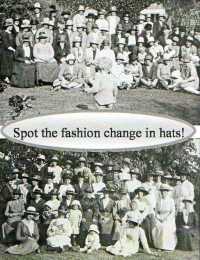 The women’s fellowship continues, though reduced in number as most women now go out to work.
The women’s fellowship continues, though reduced in number as most women now go out to work.
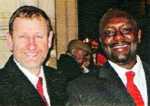 dinners, barbecues, speakers on many subjects, such as Billy Burns, a police officer shot by an armed robber who he later forgave (both pictured right), an army wife who was part of Saddam Hussein’s ‘human shield’, horse trainer, Mikey Heaton Ellis, from Barbury Castle, an antiques valuation, a quiz night, a cake decorating demonstration.
dinners, barbecues, speakers on many subjects, such as Billy Burns, a police officer shot by an armed robber who he later forgave (both pictured right), an army wife who was part of Saddam Hussein’s ‘human shield’, horse trainer, Mikey Heaton Ellis, from Barbury Castle, an antiques valuation, a quiz night, a cake decorating demonstration. few occasions when people of the village can get together for an informal chat.
few occasions when people of the village can get together for an informal chat.
 were sometimes three coach loads, as husbands and children were included, leaving at 6.00 a.m. No trip was complete without sandwiches, fish and chips and toilet stops of course. More recently some current church members have kindly funded trips. Gordon Reade (circled), still a church member, was obviously enjoying this outing!
were sometimes three coach loads, as husbands and children were included, leaving at 6.00 a.m. No trip was complete without sandwiches, fish and chips and toilet stops of course. More recently some current church members have kindly funded trips. Gordon Reade (circled), still a church member, was obviously enjoying this outing!Ministry to men
Ministry to children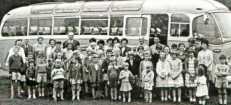

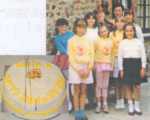
Ministry to others
 Over the years church members have been involved in the work of the local primary school. David Hewlett was headmaster from 1984 to 2004. For many years, once a week, morning worship was led by a number of volunteers and several have served on the school board of governors helping it to thrive and grow despite outside pressures and times of change. Others have supported the school in different ways such as offering expertise in photography and film making, donating money or items such as sets of bibles. Eunice Gigg’s parents. Frank & Mercy Pill were caretakers of the Mission Hall for many years from the early 1930’s. On her mothers death in 1989, Eunice inherited their estate and gave a piece of land to the school. This has been turned into a garden with an area for group use and smaller areas for individual reflection and prayer. During times of great changes, innovations and demands the school has been supported by the prayers and thoughts of the congregation and individual members.
Over the years church members have been involved in the work of the local primary school. David Hewlett was headmaster from 1984 to 2004. For many years, once a week, morning worship was led by a number of volunteers and several have served on the school board of governors helping it to thrive and grow despite outside pressures and times of change. Others have supported the school in different ways such as offering expertise in photography and film making, donating money or items such as sets of bibles. Eunice Gigg’s parents. Frank & Mercy Pill were caretakers of the Mission Hall for many years from the early 1930’s. On her mothers death in 1989, Eunice inherited their estate and gave a piece of land to the school. This has been turned into a garden with an area for group use and smaller areas for individual reflection and prayer. During times of great changes, innovations and demands the school has been supported by the prayers and thoughts of the congregation and individual members.

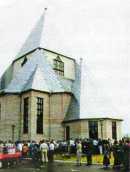 Belarus: Mark Gillingham writes “The church has supported Christians in the small town of Zaslavl, Belarus, in Eastern Europe, since shortly after the fall of Communism in Russia, 17 years ago. Our first project was to help finance a new 700 seat church in the town, and this excellent building was completed in 2002. Four church members attended the inaugural service. More recently we have supported friends in Zaslavl who are adopting young people from State Orphanages, which has transformed their prospects. One couple have adopted six teenage boys in addition to their own four children, and another are in the process of adopting 10 children. The church also sponsors Sunday school work in the town”.
Belarus: Mark Gillingham writes “The church has supported Christians in the small town of Zaslavl, Belarus, in Eastern Europe, since shortly after the fall of Communism in Russia, 17 years ago. Our first project was to help finance a new 700 seat church in the town, and this excellent building was completed in 2002. Four church members attended the inaugural service. More recently we have supported friends in Zaslavl who are adopting young people from State Orphanages, which has transformed their prospects. One couple have adopted six teenage boys in addition to their own four children, and another are in the process of adopting 10 children. The church also sponsors Sunday school work in the town”.
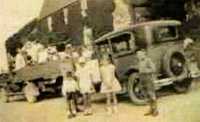 There were several highlights each year to look forward to. The summer treat was in the holidays, usually held at Ivy House. A lovely tea was made for us all, held on the lawn. Afterwards was a ‘treasure hunt’ with various little presents hidden in the garden hedges and trees. Very exciting. Afterwards, we were ushered on to Mr Dunce’s Ford lorry and driven to Ashdown woods to play and swing on the branches. Feeling very tired we were driven back to Ivy House where we had scrambles on the lawn. The Aunties (Miss Doris and Miss Irene Bunce) would throw sweets and little jem biscuits, and we would scramble for them – dirt and all!
There were several highlights each year to look forward to. The summer treat was in the holidays, usually held at Ivy House. A lovely tea was made for us all, held on the lawn. Afterwards was a ‘treasure hunt’ with various little presents hidden in the garden hedges and trees. Very exciting. Afterwards, we were ushered on to Mr Dunce’s Ford lorry and driven to Ashdown woods to play and swing on the branches. Feeling very tired we were driven back to Ivy House where we had scrambles on the lawn. The Aunties (Miss Doris and Miss Irene Bunce) would throw sweets and little jem biscuits, and we would scramble for them – dirt and all! branches) which touched the roof. Mrs Edwards and teachers would decorate it. It was loaded with a present for each pupil, that varied according to your marks. (Ray Gigg remembers making six model spitfires and hanging then on the tree as presents during the war). There were special selection boxes according to your marks also, which you went up to choose from. I always remember Mrs Edwards’ coconut ice – home made! All the parents came on this evening also. The second night was the children’s tea and games which we all enjoyed. I also remember having to go to Claremont on our birthday, when the Edwards gave us a sixpence piece – a lot of money in those days.
branches) which touched the roof. Mrs Edwards and teachers would decorate it. It was loaded with a present for each pupil, that varied according to your marks. (Ray Gigg remembers making six model spitfires and hanging then on the tree as presents during the war). There were special selection boxes according to your marks also, which you went up to choose from. I always remember Mrs Edwards’ coconut ice – home made! All the parents came on this evening also. The second night was the children’s tea and games which we all enjoyed. I also remember having to go to Claremont on our birthday, when the Edwards gave us a sixpence piece – a lot of money in those days.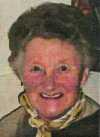 Kingstone Winslow (now gone). Due to a grievance they left the chapel and went to St Mary’s in Ashbury. My Grandmother started some Bible Studies at College Farm to gain more Bible teaching. More and more people were attending when the Misses Hedges arrived and suggested building the Mission Hall.
Kingstone Winslow (now gone). Due to a grievance they left the chapel and went to St Mary’s in Ashbury. My Grandmother started some Bible Studies at College Farm to gain more Bible teaching. More and more people were attending when the Misses Hedges arrived and suggested building the Mission Hall.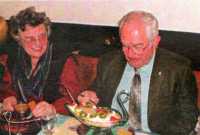 such a warm, loving fellowship. I’d met quite a few before as earlier that year they organised a coach trip for the village to hear Dr Billy Graham at Harringay. I lived in North London so met them there. I was soon ‘roped in’ to take a girls class in the flourishing Sunday school. When our three sons came along, 1955,1958 and 1960, they were all, in turn, dedicated to God in infancy. Later, each one made their own decision to accept the Lord Jesus Christ as their Saviour and Lord.
such a warm, loving fellowship. I’d met quite a few before as earlier that year they organised a coach trip for the village to hear Dr Billy Graham at Harringay. I lived in North London so met them there. I was soon ‘roped in’ to take a girls class in the flourishing Sunday school. When our three sons came along, 1955,1958 and 1960, they were all, in turn, dedicated to God in infancy. Later, each one made their own decision to accept the Lord Jesus Christ as their Saviour and Lord.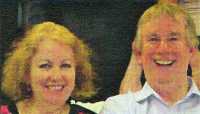 Ashbury Mission Hall was a little blue corrugated iron building perched in the village of ‘dear old Ashbury’ as Gordon Miles, a local taxi driver used to say. Inside were hung scripture pictures with beautiful illustrations by Mrs Edwards. The chairs were pink and blue with green springy tubular frames, just a few hard wooden chairs were at the back. The Pulpit was a table with a sloping wooden box on top covered in black prickly fabric. There was one huge picture scripture on the wall behind the pulpit with, ‘For other foundation can no man lay than that is laid, which is Jesus Christ.’
Ashbury Mission Hall was a little blue corrugated iron building perched in the village of ‘dear old Ashbury’ as Gordon Miles, a local taxi driver used to say. Inside were hung scripture pictures with beautiful illustrations by Mrs Edwards. The chairs were pink and blue with green springy tubular frames, just a few hard wooden chairs were at the back. The Pulpit was a table with a sloping wooden box on top covered in black prickly fabric. There was one huge picture scripture on the wall behind the pulpit with, ‘For other foundation can no man lay than that is laid, which is Jesus Christ.’Ray Gigg: Eunice Gigg’s (nee Pill) husband & Remeny’s dad  One memory I have is of sitting in my mother’s (Ethel Gigg) class early in the early 1930’s, scribbling on biblical pictures and learning ‘God is Love’, then progressing to Mrs Mabel and Mr Bert unce’s classes and finally, to Mr Alfred Edwards in The Kiln. In Mrs Bunce’s class we were encouraged to learn by heart Ecclesiastes 12:1 ‘Remember now your Creator in the days of your youth, before the difficult days come, and the years draw near when you say I have no pleasure in them.’ In the joy of youth it was difficult to imagine the experiences of the life described, as ones life progresses (all too quickly) the truth of those words dawn upon us. Both Eunice and myself are thankful for the teaching we received in our early years and the example of Mr and Mrs Edwards’ faith. We have seen a number of changes in the village over the years, to us the most significant being the growth of united Christian Fellowship in sharing and worshipping with St Mary’s from which we have received blessing and inspiration in our later years. Our hope and prayer is that closeness will continue to grow as we are all one in Christ Jesus our Lord and Savour. ‘God is Love’ (1 John Ch. 4 v 8).
One memory I have is of sitting in my mother’s (Ethel Gigg) class early in the early 1930’s, scribbling on biblical pictures and learning ‘God is Love’, then progressing to Mrs Mabel and Mr Bert unce’s classes and finally, to Mr Alfred Edwards in The Kiln. In Mrs Bunce’s class we were encouraged to learn by heart Ecclesiastes 12:1 ‘Remember now your Creator in the days of your youth, before the difficult days come, and the years draw near when you say I have no pleasure in them.’ In the joy of youth it was difficult to imagine the experiences of the life described, as ones life progresses (all too quickly) the truth of those words dawn upon us. Both Eunice and myself are thankful for the teaching we received in our early years and the example of Mr and Mrs Edwards’ faith. We have seen a number of changes in the village over the years, to us the most significant being the growth of united Christian Fellowship in sharing and worshipping with St Mary’s from which we have received blessing and inspiration in our later years. Our hope and prayer is that closeness will continue to grow as we are all one in Christ Jesus our Lord and Savour. ‘God is Love’ (1 John Ch. 4 v 8).
Amy Leon, Breakfast Club, 1988 to 1996: (pictured with Maureen Edmondson)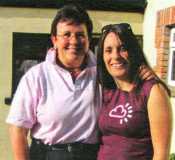
 Christmas present. In those days, money was very short and a family of six survived on a £2 a week wage. How they managed to find enough money to buy presents for all the children was a mystery to us all. Like most children from Ashbury and the surrounding area, we walked to Sunday school, all dressed in our best clothing. Betty Kingston, my two sisters and I walked from Odstone. On our way home from Sunday school, we usually played on Winslow banks. I received many a clip around the ears for getting grass stains on my best trousers through sliding down the grass bank. When HMS Amethyst escaped down the Yangtze river in July 1949, she sent the Admiralty this famous signal “One hundred up”. We now send the same message to the Ashbury Sunday School “ONE HUNDRED UP”.
Christmas present. In those days, money was very short and a family of six survived on a £2 a week wage. How they managed to find enough money to buy presents for all the children was a mystery to us all. Like most children from Ashbury and the surrounding area, we walked to Sunday school, all dressed in our best clothing. Betty Kingston, my two sisters and I walked from Odstone. On our way home from Sunday school, we usually played on Winslow banks. I received many a clip around the ears for getting grass stains on my best trousers through sliding down the grass bank. When HMS Amethyst escaped down the Yangtze river in July 1949, she sent the Admiralty this famous signal “One hundred up”. We now send the same message to the Ashbury Sunday School “ONE HUNDRED UP”.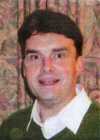 I first I first attended regularly in 1984. I was 18 and we, as a family (David, Ruth and my brother Darren) had moved churches. My memories of AEFC are from much earlier as Dad was invited to preach occasionally at evening services. I have to admit, as a child the highlight was supper afterwards with the Misses Bunce at Ivy House! They always seemed very interested in my brother and me, quite a change from other “older” ladies! They always had some new gadget (a new Swiss Cheese Slicer springs to mind!) or toy for us to play with!
I first I first attended regularly in 1984. I was 18 and we, as a family (David, Ruth and my brother Darren) had moved churches. My memories of AEFC are from much earlier as Dad was invited to preach occasionally at evening services. I have to admit, as a child the highlight was supper afterwards with the Misses Bunce at Ivy House! They always seemed very interested in my brother and me, quite a change from other “older” ladies! They always had some new gadget (a new Swiss Cheese Slicer springs to mind!) or toy for us to play with!
Ashbury Mission Hall – Statement of Faith
